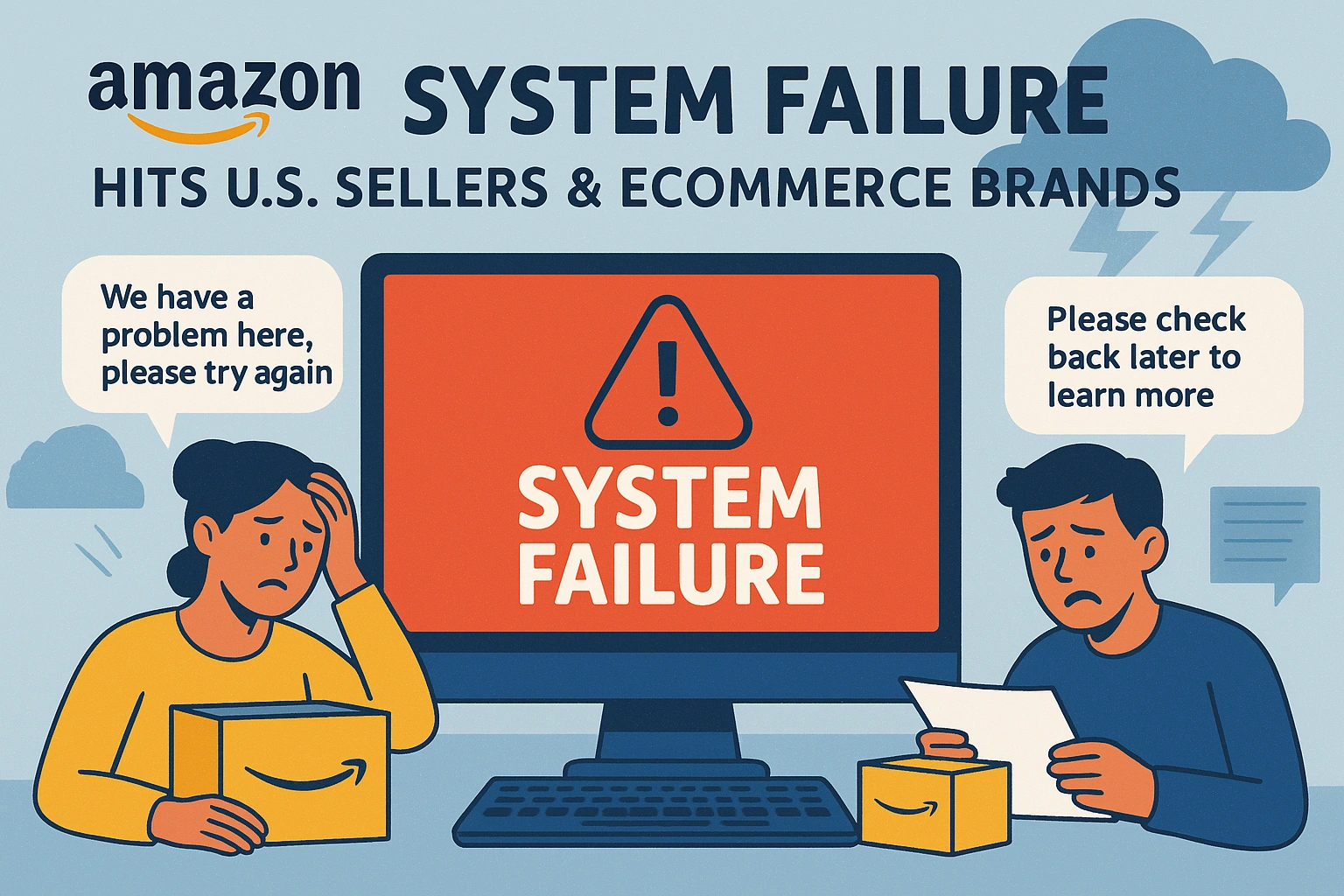Address
304 North Cardinal St.
Dorchester Center, MA 02124
Work Hours
Monday to Friday: 7AM - 7PM
Weekend: 10AM - 5PM

On October 20, 2025, Amazon suffered a severe system failure that triggered a widespread global outage, sending shockwaves through the e-commerce world. This incident, rooted in issues with Amazon Web Services (AWS), had far-reaching impacts on U.S.-based Amazon sellers and ecommerce brands, involving API interface anomalies, core functions disruption, and highlighting the risks of interconnected services.
The failure wasn’t confined to Amazon’s main marketplace. It affected global key sites, with the U.S. site experiencing a total outage and the UK site having partial functionality issues. Sellers were greeted with repeated prompts like “We have a problem here, please try again” in Seller Central. Core functions such as A+, FBA shipments, and the settlement center were unable to create or sync properly. Buyer message pages showed “Please check back later to learn more,” bringing communication to a halt.
At the core of the trouble was an API interface anomaly in Amazon’s North American region. Starting at 3 PM on October 20, 2025, North American accounts couldn’t use functions like A+, FBA shipments, STA shipments, the settlement center, multi-channel orders, MFN order fulfillment, and advertising. Industry insiders suggested that incomplete recovery of Amazon’s core database and interface synchronization was the cause.
Beyond the marketplace, Amazon’s main site, AWS, and Alexa also faced connection problems. Mobile apps crashed, voice control failed, and some users couldn’t load product and order pages on mobile apps, while voice devices stopped responding entirely.
Monitoring site Downdetector data showed that故障报告数量 soared to around 50,000 around 7:50 AM Eastern Time on October 20, 2025, the highest of the year. Over 15,000 reports were just for Amazon’s main site. The AWS US-East-1 data center failure caused multiple global internet services relying on AWS to go down simultaneously.
Major affected clients included Venmo, Blink, Ring, Robinhood, PUBG, Crunchyroll, Roblox, Whatnot, Coinbase, Snapchat, Duolingo, and Mercado Libre. This led industry experts to label it an event where “half the internet became unavailable,” making it one of the most serious AWS incidents in recent years.
From AWS’s official status page, Amazon DynamoDB was interrupted. Seventeen services were affected, including AWS Config, AWS Global Accelerator, AWS IAM Identity Center, AWS Identity and Access Management, AWS Private Certificate Authority, AWS Secrets Manager, AWS Security Token Service, AWS Support API, AWS Support Center, AWS Systems Manager, AWS VPCE PrivateLink, Amazon CloudFront, Amazon CloudWatch, Amazon Elastic Compute Cloud (EC2), Amazon Elastic Kubernetes Service (EKS), Amazon Kinesis Data Streams, and Amazon VPC Lattice.
For U.S.-based Amazon sellers, this outage meant halted operations. The inability to manage listings, process FBA shipments, or access settlement data caused significant disruptions. Ecommerce brands that rely on Amazon for a large portion of their sales faced lost revenue as customers couldn’t place orders or even browse products properly.
The interconnected nature of services means that issues with AWS don’t just affect Amazon but also countless other platforms and tools that businesses use. This underscores the risk of relying heavily on a single cloud provider and the need for contingency plans.
While Amazon and AWS work to prevent such large-scale outages, businesses must also take steps to protect themselves. This includes having backup systems, diversifying cloud service providers if possible, and regularly testing disaster recovery plans. Staying informed about the status of critical services and having clear communication channels with teams can also minimize the impact when disruptions occur.
If your business was affected by the Amazon system failure and AWS outage, or if you want to prepare better for future disruptions, reach out to us. Our team of experts can help you assess your current setup, develop contingency plans, and ensure your ecommerce operations remain resilient. Don’t let unexpected outages derail your business—get in touch today.
The failure was primarily due to an API interface anomaly in Amazon’s North American region, with incomplete recovery of Amazon’s core database and interface synchronization contributing to the issue. The AWS US-East-1 data center failure also played a role, causing multiple dependent services to go down.
The exact duration can vary, but monitoring data showed a surge in故障报告 starting around 7:50 AM Eastern Time on October 20, 2025, and Amazon worked to resolve the issues. The recovery process for all services might take some time, and it’s best to check Amazon’s official status updates for the most accurate timeline.
Sellers should consider having backup systems in place, diversifying cloud service providers if feasible, regularly testing disaster recovery plans, and staying informed about the status of critical services. Having clear communication channels with teams and a contingency plan can also help minimize the impact of future disruptions.